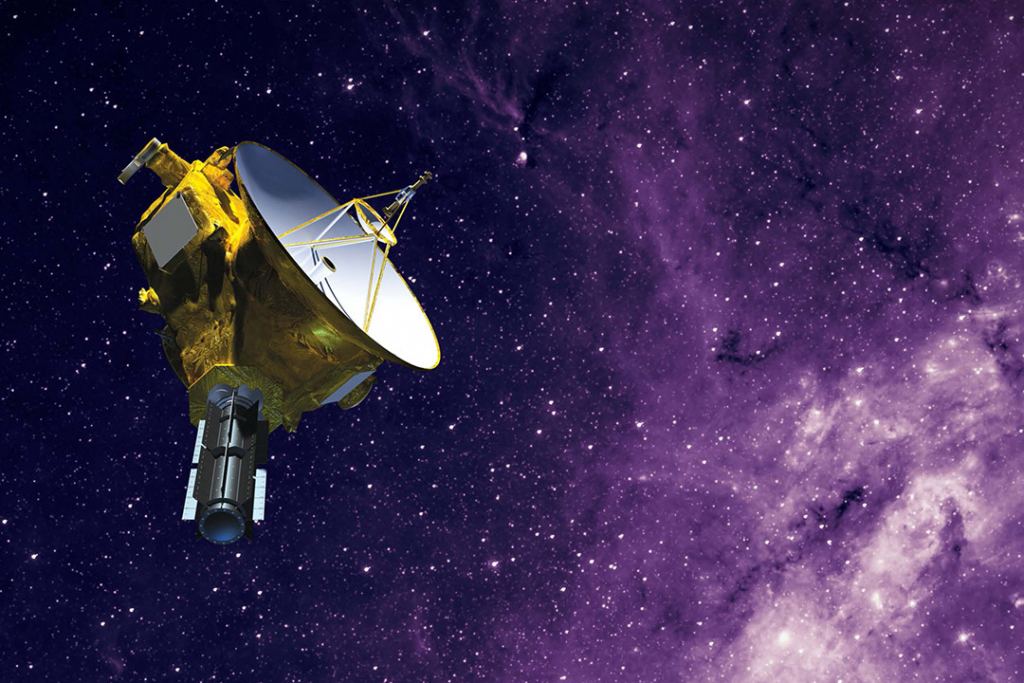Over seven years ago, the New Horizons mission made history when it became the first spacecraft to conduct a flyby of Pluto. In the leadup to this encounter, the spacecraft provided updated data and images of many objects in the inner and outer Solar System. Once beyond the orbit of Pluto and its moons, it embarked on a new mission: to make the first encounter with a Kuiper Belt Object (KBO).
This historic flyby occurred about four years ago (Dec. 31st, 2015) when New Horizons zipped past Arrokoth (aka. 2014 MU69).
Now that it is passing through the Kuiper Belt, away from the light pollution of the inner Solar System, it has another lucrative mission: measuring the brightness of the Universe. These measurements will allow astronomers to make more accurate estimates of how many galaxies there are, which is still the subject of debate. According to new measurements by New Horizons, the light coming from stars beyond the Milky Way is two to three times brighter than the light from known populations of galaxies – meaning that there are even more out there than we thought! The study was led by a team from the Center for Detectors (CfD), an academic research group at the Rochester Institute of Technology (RIT).
They were joined by researchers from NASA’s Jet Propulsion Laboratory, the Space Exploration Sector (SES) at the Johns Hopkins University Applied Physics Laboratory (JHUAPL), the University of California Irvine, and the Space Sciences Laboratory (SSL) at UC Berkeley. The paper that describes their findings recently appeared online and has been accepted for publication in The Astrophysical Journal. The overall brightness of the Universe is known as the Cosmic Optical Background (COB), which includes the diffuse light given off by all the stars and galaxies in the Universe combined.
Like the Cosmic Microwave Background (CMB), the relic radiation left over from the Big Bang, this value is important to astronomers because it allows them to take an inventory of all the normal matter (aka. “luminous matter”) in the Universe. This is a challenge here on Earth because of interference caused by sunlight and the way it’s reflected by ice particles throughout the Solar System (known as Zodiacal Light).
Space-based telescopes that orbit close to Earth are also subject to interference because of dust between planets that creates foreground light. But any interfering light in the foreground is minimal for a mission like New Horizons, now deep into the Kuiper Belt and on its way out of the Solar System. To calculate the COB, the team analyzed hundreds of images of background light taken by the New Horizon’s Long-Range Reconnaissance Imager (LORRI).
Teresa Symons, a postdoctoral researcher at the University of California Irvine, led the study as part of her dissertation while studying for her Ph. D. at the Rochester Institute of Technology (RIT).
As she explained in a recent RIT press release: “We see more light than we should see based on the populations of galaxies that we understand to exist and how much light we estimate they should produce. Determining what is producing that light could change our fundamental understanding of how the universe formed over time. ” Previous measurements made in 2021 by researchers from the Space Telescope Science Institute (STScI) revealed that the COB was brighter than expected.
This was followed by an independent team of scientists earlier this year that found that the COB was twice as large as originally believed. These latest results validate these previous studies using a much broader set of LORRI observations and hint that there must be additional light sources in the cosmos we have not yet accounted for. Currently exploring the Kuiper Belt, New Horizons is just one of five spacecraft to reach beyond 50 AUs, on its way out of the Solar System and, eventually, into interstellar space.
Credit: NASA/Johns Hopkins APL/SwRI The New Horizons mission is currently more than 55. 85 Astronomical Units (AU) from Earth (or 8. 35 billion km; 5.
19 billion mi) – almost 56 times the distance between the Earth and the Sun. At this distance, where the foreground light is minimal, astronomers have a much clearer view of the cosmic background and can make more accurate inferences about its galactic population. Symons and her colleagues hope that these observations will pave the way for future missions and instruments that can help explore this discrepancy further.
These include Caltech’s Cosmic Infrared Background ExpeRiment-2 (CIBER-2) and NASA’s Spectro-Photometer for the History of the Universe, Epoch of Reionization and Ices Explorer (SPHEREx), which will conduct spectro-photometric fluctuations of the cosmic background to learn more about galaxy formation and cosmic evolution since the Big Bang. Co-author Michael Zemcov, a researcher at NASA JPL and a research professor at the RIT’s CfD and School of Physics and Astronomy, will play a major role in the SPHEREx mission and its data pipeline. “This has gotten to the point where it’s an actual mystery that needs to be solved,” he said.
“I hope that some of the experiments we’re involved in here at RIT, including CIBER-2 and SPHEREx can help us resolve the discrepancy. ” Further Reading: Rochester Institute of Technology, arXiv The post The Universe is Brighter Than we Thought appeared first on Universe Today. .
From: universetoday
URL: https://www.universetoday.com/159373/the-universe-is-brighter-than-we-thought/



